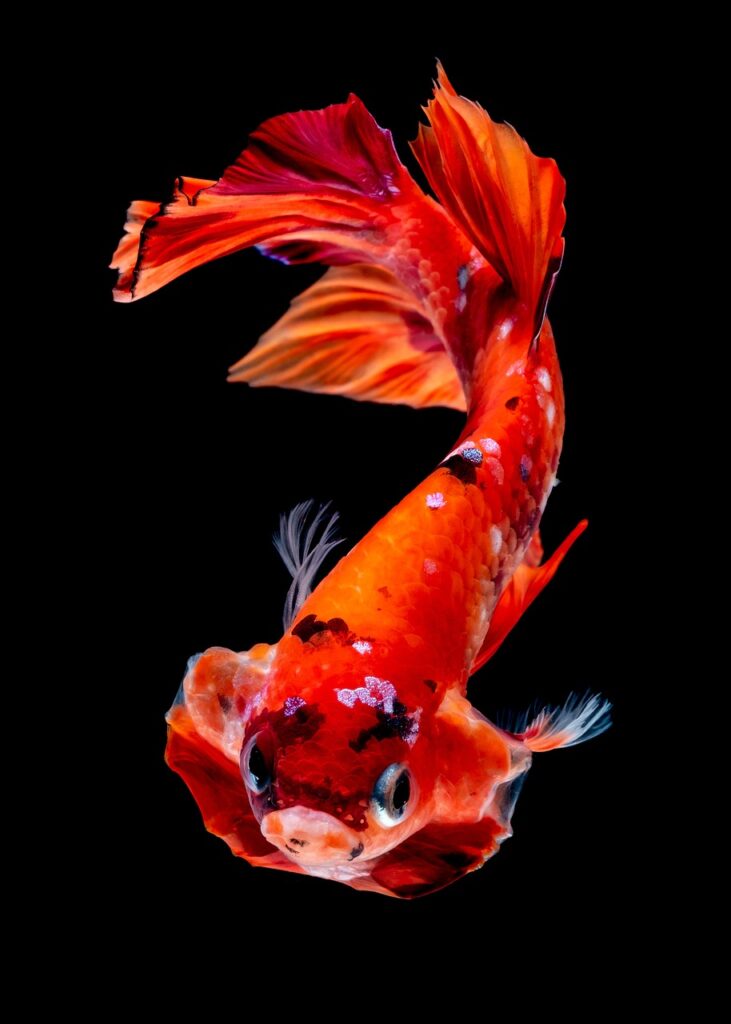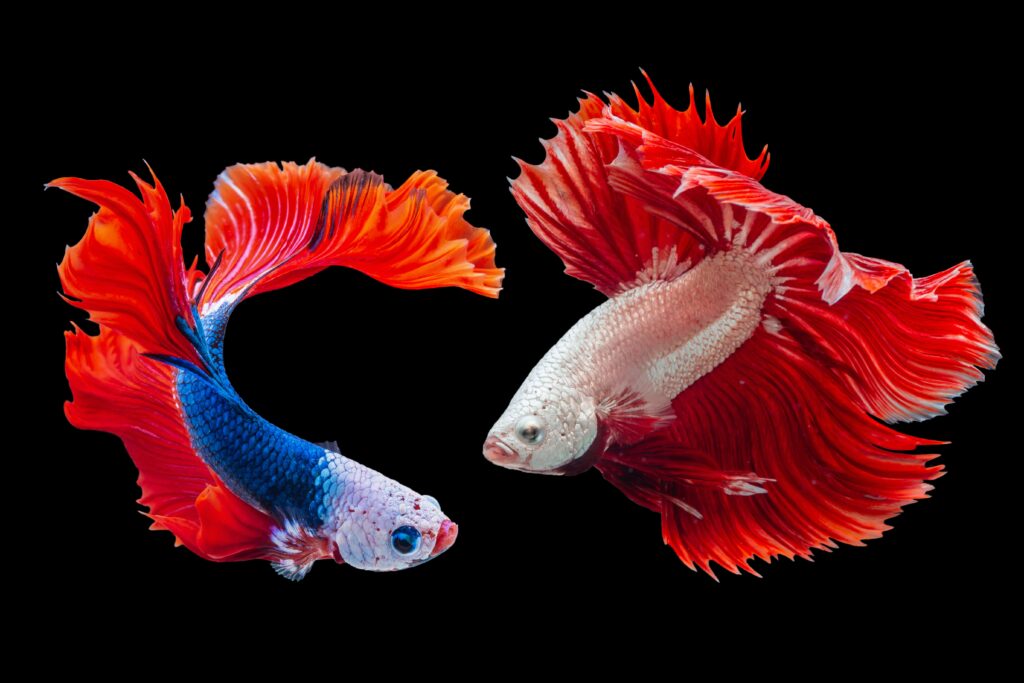Hey there, fellow fish enthusiast! 🐟 So, you’ve probably heard about the betta fish, right?
Those vibrant, fan-tailed wonders often flare their fins in little cups at the pet store. Yep, they’ve got a bit of a reputation – and it’s not just for their fabulous looks.
Ever wonder why they’re called Siamese Fighting Fish?
Let’s dive deep into one burning question that keeps popping up: Do betta fish eat each other? Trust me; it’s a fishy tale worth hearing! Buckle up, and let’s dive right in.
Historical Background
Alright, gather ’round, fishy friends, and let’s take a splash into history! Back in the day—like way, way back—bettas were discovered in the rice paddies, shallow ponds, and slow-moving streams of Southeast Asia, particularly Thailand. And you know what? Back then, Thailand was known as Siam—aha! Hence the name Siamese Fighting Fish. Clever, right?
You might think, “Okay, but why ‘Fighting Fish’? Were they in some fishy Fight Club?”
Well, not quite, but close enough. Local folks noticed that these fish, especially the males, had quite a temper when put together. They’d flare their fins, show off their bright colors, and, yep, throw down some aquatic WWE moves.
This behavior turned into a form of entertainment. People even started placing bets on these fishy face-offs, which, believe it or not, is where the name “betta” might have originated – from an ancient clan of warriors known as the “Bettah.”
Crazy, right? But it wasn’t all fun and games. This aggressive nature led to misconceptions, myths, and many questions. Like our big one: do they actually munch on each other? Let’s keep swimming through this topic to find out!
Betta Fish Aggression: Fact vs. Myth
Alright, here’s where things get a tad fishy (pun totally intended!). When it comes to betta fish, it seems like everyone and their grandmother has a story or a theory about their aggression. So let’s break it down, myth-buster style, and separate the real deal from the tall tales.
Fact: Male betta fish are territorial. Have you ever seen a betta flare up its gills and spread those majestic fins when another betta (or its own reflection) comes into view? That’s them saying, “Back off; this is my turf!” It’s like their version of flexing in front of a mirror at the gym. 💪
Myth: All betta fish hate each other. Not so fast! While male bettas are known to be aggressive with each other, female bettas can sometimes coexist in what’s called a “sorority” if given enough space and hiding spots. However, it’s a delicate balance and not a guaranteed peace fest.
Fact: Bettas will show aggression towards flashy, finned fish. Consider it this: If another fish looks too much like a betta (bright colors, long fins), Mr. Betta might mistake it for a rival and decide it’s showdown time.
Myth: Bettas are always aggressive. Nope! They can be quite docile and curious alone or with suitable tank mates. It’s all about understanding their needs and setting them up for success.
We’ve clarified some misconceptions, but what about the BIG question? The one about them possibly eating each other? Keep those snorkels on; we’re diving deeper to find out!

Why Do Betta Fish Eat Each Other?
Dive a bit deeper, and you’ll realize that the underwater world can be as dramatic as any soap opera on TV. So, do these little divas really resort to cannibalism? Let’s break it down.
- Misunderstood Aggression: More often than not, bettas aren’t trying to eat each other but rather establish dominance or protect their territory. Those nips and bites? It’s their way of saying, “Back off, buddy!” However, these aggressive spats can sometimes lead to severe injury, especially if the fish are trapped in a small space together.
- Baby Betta Drama: Here’s a plot twist – after breeding, female bettas might consume their eggs or fry (baby bettas) if they feel threatened or stressed. It’s a natural, albeit heart-wrenching, instinct to prevent other predators from getting to them. But it’s not a case of adult bettas munching on their fully-grown peers.
- Hungry or Stressed: Sometimes, if a betta is incredibly stressed or hasn’t been fed properly, it might lash out more aggressively. But again, this isn’t about them trying to eat another betta; it’s more about high-stress levels and a tad of hunger-fueled rage.
- Mistaken Identity: In rare cases, if a fish is small enough and resembles food, a particularly aggressive or hungry betta might try it. But another full-grown betta? Not entirely on the menu.
While bettas are known for their aggressive attitude, they aren’t out there looking to make a meal out of their fellow tank-mates. But as with all dramatic tales, the truth lies in the details. Stick around as we delve even deeper into this underwater saga.
Signs of Aggression in Betta Fish
Alright, so now that we’re all up to speed on betta drama, let’s get to the signs. Like that one friend who’s super expressive when they’re annoyed (you know who I’m talking about), bettas have their unique way of showing when they’re just not feeling it. Let’s decode the betta body language, shall we?
- Flaring Fins and Gills: This is like the betta version of rolling up sleeves before a bar brawl. When a betta fish opens its gills and fans out those beautiful fins, it’s gearing up for a showdown. Often, it’s a sign of an impending territorial dispute.
- Chasing and Nipping: If you see your betta darting after another fish or its fellow betta, that’s a clear sign it’s in aggressive mode. And nipping? Well, that’s the fishy equivalent of a slap in the face.
- Stress Stripes: Betta fish can sport horizontal stripes when stressed out. These can be subtle, so you must play detective and look closely. It’s like they’re wearing their emotions on their sleeves… or scales.
- Color Changes: An aggressive or stressed betta may sometimes pale in color. On the flip side, they may also darken if they’re trying to assert dominance. It’s their unique way of mood dressing.
- Guarding a Spot: Got a little cave or a fabulous plant in the tank? If your betta hovers around it like a guard dog, it’s staking a claim. Other fish, beware!
- Posturing and Puffing: Sometimes, a betta will try to make itself look bigger by puffing up and showing dominance without going into full attack mode. Think of it as their version of puffing out their chest and standing tall.
Recognizing these signs is step one. What’s next? Let’s chat about how to ensure everyone in the tank plays nice—or at least, as lovely as fish can get. Dive in with me!
Can Two Male Betta Fish Live Together?
Okay, here’s a question that’s as old as the hills and has sparked more debates than you’d believe: Can two male betta fish share a tank without going all gladiator on each other? Let’s dive into the nitty-gritty.
- Natural Instincts: Male bettas have a hard-wired instinct to defend their territory. This is crucial for survival in the wild—keeping other males away means more resources and better chances during mating season.
- Tank Territory Troubles: In the close quarters of a tank, these territorial disputes can get a bit… intense. With nowhere to escape, two males are likely to fight, leading to stress, injury continuously, and sometimes even death.
- But What About Big Tanks?: Some aquarists argue that with a large enough tank filled with plants, caves, and hiding spots, two males might coexist. The logic is if they each have their territory and can’t see each other, all’s well. But, and it’s a BIG but, this is a risky venture and often not recommended for betta beginners or the faint-hearted.
- The Divider Solution: A more secure way to house two male bettas in one tank is by using a divider. This ensures they each have their own space without the risk of physical confrontations. Still, they can sense each other’s presence, which can be a stress factor. If you’re considering this, research the best types of dividers. Here’s a handy link to get you started: Betta Fish Dividers Guide.
- Peaceful Cohabitation: Now, if you’re dreaming of a quiet tank community, consider pairing a male betta with non-aggressive, non-flashy fish. There’s a whole world of fishy friends out there who are less likely to ruffle your betta’s fins.
In conclusion? While it’s technically possible for two male bettas to live in the same tank, it’s a tightrope walk. You’d need to be vigilant, patient, and ready to step in if things get heated. If you’re in doubt? Play it safe, and let your betta have its own solo pad.

How to Prevent Aggression and Cannibalistic Behaviors
Now that we’ve peeked behind the curtain of betta drama let’s discuss the proactive steps you can take to ensure peace and calm reign in your underwater kingdom. After all, your tank should be more of a relaxing spa retreat and less of a gladiator arena.
- Tank Size Matters: Size isn’t everything, but it is when it comes to betta tanks. A bigger tank means more roaming space, fewer territorial disputes, and lower stress levels. Aim for a minimum of 5 gallons for a single betta. Trust me, your fishy friend will thank you.
- Interior Design, Betta-Style: Betta fish love nooks and crannies. Plants, caves, and other hiding spots allow them to establish territories, reduce their line of sight with potential “rivals,” and give them a sense of security. Silk plants or live plants like Anubias and Java Ferns are great choices.
- Avoid Reflections: Ever seen a betta flare at its own reflection? It’s like having a constant rival in the mirror. Reduce reflections in the tank by placing it away from direct sunlight and considering the lighting you use.
- Temperature and Water Quality: Keeping your tank’s water conditions optimal. Bettas prefer water temperatures between 76-80°F (24-27°C). Clean, well-filtered water with regular changes can significantly reduce stress, reducing aggression.
- Feeding Regimen: A hungry betta is a cranky betta. Regular feedings can prevent hunger-induced aggression. Also, having a varied diet can keep them content. Think high-quality betta pellets, occasional bloodworms, and daphnia.
- Observation: Spend time watching your betta(s). Being familiar with their behaviors helps in the early detection of stress or aggression, allowing you to act before things escalate.
- Quarantine New Additions: If introducing new fish into a betta tank, quarantine the newcomers first. This ensures they aren’t carrying diseases and gives your betta time to adjust to the idea of having new neighbors.
- Research Tankmates: If you hope to have a community tank, do your homework. Some fish species get along with bettas better than others. Avoid fish that are too colorful or have long fins, as these might trigger your betta’s aggressive side.
Remember, each betta has its own personality. What works for one might not work for another. The key is patience, observation, and a bit of aquatic intuition. Your betta can lead a peaceful, stress-free life with the proper care and environment. Dive into this journey with understanding and empathy, and you’ll set the stage for a harmonious underwater world!
What to Do If Your Betta Fish Are Showing Aggression
Alright, fishkeepers! We’ve got our tanks set, our plants in place, and yet, drama ensues. It’s like a soap opera in aquatic form. But don’t fret. If your betta is turning into a mini Jaws, there are steps you can take to restore peace in the deep. Let’s reel in that aggression.
- Immediate Separation: If two bettas are duking it out, it’s time for a time-out. Safely and gently move one to a separate container, ensuring similar water conditions to avoid further stress.
- Check the Environment: Are there enough hiding spots? Is the water temperature right? Sometimes adjusting the tank environment can tone down aggressive behavior.
- Reduce Reflections: If your betta continuously flares and attacks the tank walls, it might be seeing its reflection. Adjust the tank lighting or rearrange the tank’s location to minimize reflections.
- Invest in a Tank Divider: If you’re determined to house two bettas in one tank (especially two males), a divider is necessary. This ensures each betta has its territory. A solid divider, rather than a see-through one, can effectively reduce aggression.
- Distraction Techniques: Consider adding live food, like brine shrimp or daphnia. They are delicious treats, but hunting them can distract from aggressive behavior.
- Consult Experts: Head to your local fish store or join an online betta forum. Talking to other betta enthusiasts can offer insights and solutions you might not have considered. One highly recommended online community is the Betta Fish Enthusiasts Forum, where seasoned keepers share advice and experiences.
- Consider Rehoming: Sometimes, despite our best efforts, certain bettas might need to be more moderate for community living. If that’s the case, it might be kinder to rehome the betta to a solo tank where it can live stress-free.
- Stay Calm and Keep Observing: Fish-keeping requires patience. Keep a close eye, make adjustments as needed, and remember that every betta is unique. What soothes one might not work for another, so be ready to adapt.
While betta fish are known for their aggressive nature, you can prevent, manage, and reduce aggressive behaviors with understanding and proper care. Here’s to a harmonious fish tank and happy betta buddies!
Conclusion
Whew! Who knew that such intricate behaviors and dynamics lurked behind those shimmering scales and flowing fins? From the dramatics of betta soap operas to the do’s and don’ts of communal living, we’ve swum through the depths of betta care together.
Like any pet, keeping bettas is a commitment—a blend of science, art, and a sprinkle of patience. They’re not just ornamental additions to our homes; they’re living beings with personalities, quirks, and, yes, even little tempers.
But here’s the thing: with the proper knowledge in our back pocket (or should I say, fish net?), we can create a serene underwater utopia where our finned friends can thrive. Remember, a happy betta isn’t just about pretty colors or impressive fin displays; it’s about the twinkle in their eye (do fish have twinkles?) and their tail’s graceful, content swish.
So, to all the fish keepers, from the rookies to the seasoned pros, here’s to clear waters, peaceful tanks, and bettas living their best lives. Dive into the experience, learn from each ripple, and may your fish tales be full of joy and wonder. 🐠💙🌊
Happy fish-keeping, and until our next aquatic adventure!
FAQ
Q: Can betta fish recognize their owners?
- A: Surprisingly, yes! Bettas can become familiar with their owners. Some bettas even “dance” or get more active when they see their human approaching. It’s a fishy way of saying, “Hey there!”
Q: Can I put live plants in my betta tank?
- A: Absolutely! Bettas love live plants. They offer hiding spots and can help improve water quality. Plants like Java Fern, Anubias, and Moss Balls are popular choices for betta tanks.
Q: Why is my betta hiding all the time?
- A: Bettas sometimes hide when stressed, scared, or adjusting to a new environment. Ensure that the water conditions are optimal and there are no aggressive tankmates. Give your betta some time to adapt.
Q: Can I touch my betta fish?
- A: It’s best to avoid handling your betta. They have delicate fins and a protective slime coat that handling can damage. If you need to move your betta, use a soft net.
Remember, the journey of fish-keeping is filled with learning. As you spend more time with your finned buddy, you’ll learn its habits and preferences. Embrace the ripples, enjoy the flow, and always stay curious!
